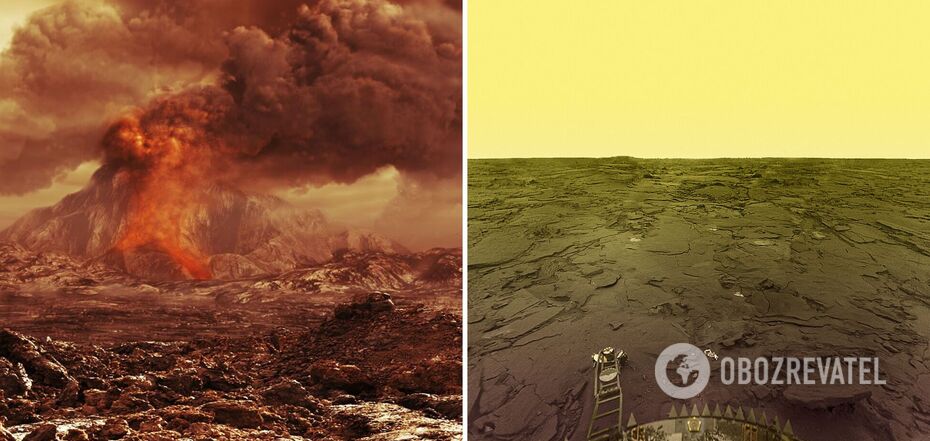Life
How Venus turned into Earth's infernal twin: scientists discover the cause
Scientists have long assumed that Venus was once the Earth's twin planet with a mild and humid climate, where even life was possible. But now it is a hot ball with a strong greenhouse effect and an atmosphere filled with fog made up of 80% sulfuric acid. How it turned into this hell is a mystery that scientists are struggling with.
According to Space.com, the prevailing assumption now is that the huge activity of volcanoes, multiplied by the fact that Venus is closer to the Sun, is to blame. According to observations, the temperature on the surface of our neighbouring planet is 464 degrees Celsius, which is enough to melt lead. And under the dense clouds of carbon dioxide impregnated with caustic sulphuric acid, a crushing pressure of 90 atmospheres is felt. Venus, often referred to as Earth's "evil twin", is a victim of the powerful greenhouse effect, exacerbated by the fact that the planet is about 40 million kilometres closer to the Sun than Earth and therefore receives more heat.
The new paper on Venus was published by Michael Wei of NASA's Goddard Space Flight Centre in Maryland. He led the research, which aimed to form a new vision of the planet's evolution. After analysing the available data and making their observations, scientists claim that it was volcanism that caused the planet's atmosphere to be filled with carbon dioxide, which led to the formation of modern catastrophic conditions.
In the 1990s, NASA's Magellan spacecraft made a radar map of the surface of Venus, which it studied through its dense atmosphere. It turned out that most of its surface is covered with volcanic basalt rocks. Such "large magmatic provinces" are the result of extreme volcanic activity that lasted for tens of thousands or even hundreds of thousands of years. Most likely, this period occurred relatively recently - somewhere within the last billion years.
During this time, lava covered hundreds of thousands of square kilometres of the surface of Venus, and carbon dioxide, which is classified as a greenhouse gas, accumulated in the atmosphere. At some point, there was so much of this gas that the existing climate could not cope with it. If there were oceans on the planet, they began to evaporate, making the atmosphere more humid. And since water vapour is also a greenhouse gas, the process of surface heating only accelerated. Presumably, the water eventually escaped into outer space, and the carbon dioxide remained to do its job.
According to Wei, it is important to study the processes that destroyed Venus because of the likelihood of a cataclysmic event happening again on Earth. In particular, researchers attribute numerous episodes of mass extinction over the past 500 million years to the activity of supervolcanoes. For example, the mass extinction in the Late Devonian era 370 million years ago is attributed by some to a supervolcanic eruption in Siberia and a separate similar event in Australia. The Triassic-Jurassic mass extinction is often blamed on the formation of the largest of the Earth's geological formations formed by an eruption - the Central Atlantic Magma Province, which was formed 200 million years ago. Even the death of the dinosaurs 65 million years ago could have been caused by a double cataclysm - an asteroid impact and supervolcanism in modern India.
For some unknown reason, similar volcanic events on Venus were much more common and triggered an unstoppable greenhouse effect that changed the planet, turning it into a living hell. Meanwhile, on Earth, the carbon-silicon cycle, which acts as the planet's natural thermostat by exchanging carbon dioxide and other greenhouse gases between the mantle and atmosphere over millions of years, has been able to protect the climate from such a development.
Two upcoming NASA missions to Venus should collect more data on this subject. DAVINCI will study the noble gases and chemistry of the planet and take photographs of its surface from the deep atmosphere. The spacecraft is due to be launched at the end of this decade. And in the early 2030s, VERITAS will be launched, a mission that will study the planet's emissivity, radiology, spectroscopy and topography. "The main goal of DAVINCI is to narrow down the history of water on Venus and find out when it might have disappeared to better understand how Venus' climate has changed over time," Wei explained.
Also in the 2030s, the European Space Agency's EnVision mission is due to go to Venus. China is currently planning to launch its own spacecraft. Its project is called Voice (Venus Volcano Imaging and Climate Explorer), which, if launched, will reach Venus in 2027 to study the planet's atmosphere and geology.
As OBOZREVATEL wrote, scientists suggest that life could well have existed on Venus before its transformation.



























